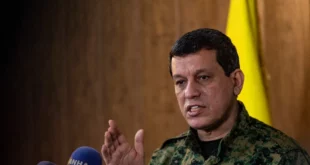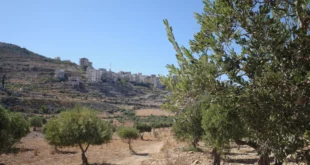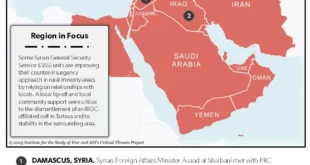As Moscow deploys troops at the behest of its Central Asian neighbor, where do Kazakhstan’s explosive protests go from here?
What started last week as a protest against fuel price increases has quickly turned into a nationwide movement that is taking aim at Kazakhstan’s elite political and economic leaders — in particularly, the semi-retired former President Nursultan Nazarbayev, whose continued role in political affairs has become a focal point of popular discontent. The demonstrations have become increasingly violent in recent days, as protesters clash with Kazakh police and Russian military personnel have been brought in at the request of Kazakhstan’s president. USIP’s Gavin Helf and Donald Jensen discuss where these explosive protests came from, Moscow’s increasing role in the crisis and where Kazakhstan goes from here.
Kazakhstan is the wealthiest Central Asian republic and — until now — has been the most stable. Is this all out of the blue or have warning signs been visible for a while?
Helf: In many ways, Kazakhstan is a poster child for the new “techno-authoritarianism” and a model of a successful petrostate. It has been careful about investing its oil wealth to create a robust, diverse economic future beyond petroleum and has done better at sharing the wealth throughout the society than many of its neighbors. It is now an upper middle-income economy that attracts foreign labor — unlike its neighbors, who are dependent on labor migrant remittances from Russia.
Problems in the past that have led to protests have been usually localized and/or narrowly focused —such as labor unrest in Western Kazakhstan, protests over land ownership (especially by Chinese companies), inter-ethnic conflicts and protests over consumer debt relief and inflation.
As in a lot of places, Kazakhstan’s good economy has been shaken by COVID and government has lost some of its shine over the last two years. Corruption, always endemic at some level, has become more offensively obvious during COVID. What has been surprising this time, though, is the sudden and wide geographic spread of the discontent and its initial lack of focus.
Kazakhstan saw local protests get out of hand ten years ago, but a brutal, heavy-handed crackdown was employed to quell them. In the interim, authorities have tried to learn from that experience and developed a more sophisticated game plan. So far, they’ve tried to address concerns over fuel price hikes by reversing — and then cutting — the prices, and then cutting prices on other commodities and making other economic concessions. When that didn’t work, they blamed the ministries and the prime minister, who the president then fired as a scapegoat. This, again, has not worked to quell the protests.
Who are the protesters then, and how has this developed?
Helf: It is very hard to get a clear picture right now, but the protests up until Wednesday were faceless, peaceful and seemed to be consistent with the kind of post-COVID economic revolt that the government thought it could buy off.
Then things took a very different turn. The protests suddenly became focused on the country’s semi-retired first president Nursultan Nazarbayev. After his official retirement in 2019, he has been publicly revered as “The Leader” and “Father of the Nation.” But as these protests developed, statues of him started to fall and reports of him preparing to seek medical treatment abroad and of his family members fleeing by private jet started to circulate. Right now, it’s not clear why this happened.
His hand-picked successor, President Kassym-Jomart Tokayev, also removed him from his chairmanship of the National Security Council and very quickly started to purge Nazarbayev’s loyalists in key positions. We still don’t know where Nazarbayev is, what role he is playing at this time or whether he is actively opposing Tokayev’s purge.
The situation on the ground changed on Wednesday night as well — turning violent. In Almaty, armed protesters seized the country’s major airport, as well as important government buildings, which they set ablaze.
What we may be seeing — in addition to a “people-power” revolt — is also a catastrophic failure of Nazarbayev’s managed transition to his successor, Tokayev, playing out in real time. Transition from one ruler and ruling family to another is a huge weak spot in authoritarian, oligarchical systems. It seldom goes well, as a fading leader tries to secure both his political legacy and the wellbeing of his family after his own passing.
January 4 also marked the 20th anniversary of the suppression of the Democratic Choice of Kazakhstan — a pro-reform, pro-Nazarbayev political movement that Nazarbayev turned against. One of their leaders, Mukhtar Ablyazov, has been very actively trying to promote regime change from abroad since his exile, and has popped up all over foreign media this week, seeming to speak for the protesters. He is likely to figure prominently in any hunt for a “foreign” hand in this drama, regardless of what he actually did over the last few days.
It’s also important to remember that in Kazakhstan, there really is no democratic opposition waiting in the wings. The government has either coopted or suppressed anyone even mildly critical of its policies over the last three decades. There are, however, plenty of grievances that nativists, Islamic extremists, xenophobes and others could try to exploit — along with plenty of political entrepreneurs with their own agendas who will try to take advantage of the situation and bend it to their own goals. Whatever comes next will likely be messier than what has come before.
President Tokayev has appealed to the Moscow-dominated Collective Security Treaty Organization (CSTO) for assistance. How has Russia responded to the request, and what is motivating Moscow’s decision-making in regard to Kazakhstan?
Jensen: On January 6, Kazakh President Tokayev claimed that unrest in his country was due to “an invasion of bandit formations trained from abroad” and requested the assistance of the Russian-led Collective Security Treaty Organization (CSTO). In response, the CSTO officially announced the start of a peacekeeping mission in Kazakhstan that would be tasked with the protection of state and military facilities and assistance to police forces. Russian airborne special forces have already begun arriving in the country, and reports indicate they will send a few companies but no more than 5,000 troops total.
Russia’s immediate goal in Kazakhstan is most likely the containment and suppression of political instability at its southern border. In addition, Russia has numerous interests in Kazakhstan, including military installations, the Cosmodrome at Baikonur and valuable business investments. The protection of these locations from violent disruption is probably of paramount importance to the Kremlin.
In the long term, it’s unlikely that Moscow sees the current unrest in Kazakhstan (and the CSTO response to that unrest) as an opportunity to crystalize or serve some broader strategic approach. The events in Kazakhstan also come at an inconvenient time for the Kremlin, with its attention focused on Ukraine, where Russia has massed forces near the Ukrainian border in an effort to gain concessions from Ukraine and its Western supporters either through saber rattling or a real invasion.
With that military deployment underway, it is highly unlikely the Kremlin would use the current situation in Kazakhstan as an opportunity to use military force in Central Asia or to assert a new foreign policy doctrine. Russian policy has not been consistent regarding defense of neighboring authoritarians, and in the case of Kazakhstan, it’s not even clear whether they would be intervening to stop a democratic revolution or to stop internecine elite fighting. It is far more probable that the Kremlin is responding to events with the minimal force necessary to protect Russia’s interests.
 Eurasia Press & News
Eurasia Press & News



